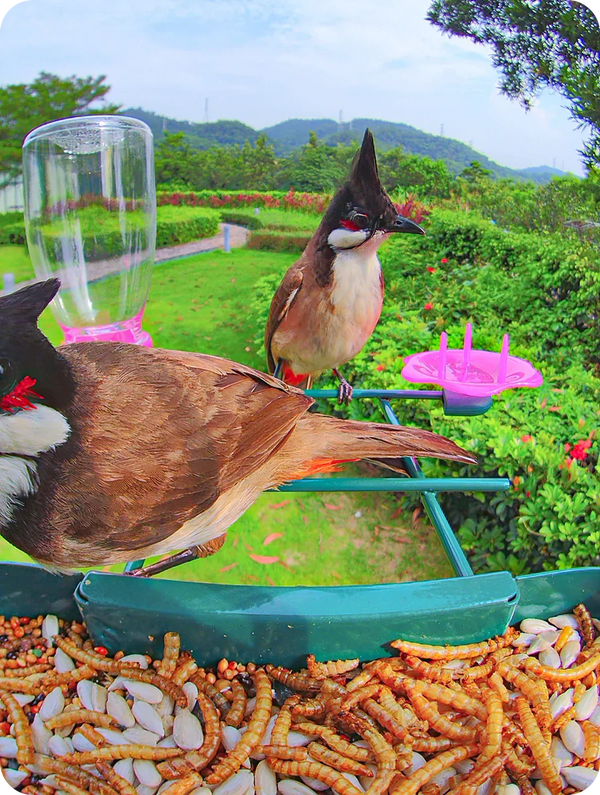Discover the Secret World of Bird Feeders: Transform Your Backyard into a Feathered Paradise!
Bird feeders are more than just simple structures to hold seeds; they are gateways to a vibrant world of nature right in your backyard. The joy of watching various bird species flit and flutter about as they feed is an experience that can bring tranquility and delight to anyone. Birdwatching not only offers a peaceful respite from the hustle and bustle of daily life but also fosters a deeper appreciation for the environment. By providing food and shelter through feeders for birds, you play a vital role in supporting local wildlife, especially during harsh weather conditions when food sources are scarce. Whether you're a seasoned bird enthusiast or a casual observer, setting up a bird feeder can transform your outdoor space into a lively haven for feathered friends.

Types of Bird Feeders
There are several types of bird feeders, each designed to cater to the unique feeding habits of different bird species. Understanding these types can help you attract a diverse range of birds to your yard. Platform feeders are open trays that allow birds to feed from all sides, making them accessible to a variety of species. Tube feeders are cylindrical and often come with small feeding ports, ideal for keeping seeds protected from the elements. Suet feeders, designed to hold high-fat treats, attract woodpeckers and other insect-eating birds. For those who want to attract hummingbirds, specialized feeders filled with nectar are essential. By selecting the right feeder for your backyard, you can create a welcoming space for birds of all shapes and sizes.
Platform Feeders
Platform feeders are the most versatile type of bird feeder, featuring a flat surface that can accommodate multiple birds at once. They usually come with a roof to shield seeds from rain and snow. These feeders attract a wide range of birds, including cardinals, sparrows, and finches, making them a popular choice among birdwatchers. Their open design allows for easy access, which is especially beneficial for ground-feeding birds.
Tube Feeders
Tube feeders are characterized by their long, cylindrical shape and often include multiple feeding ports that allow several birds to feed simultaneously. These feeders are excellent for preventing seed spillage, as the seeds are contained in the tube until a bird accesses them. Tube feeders are particularly appealing to smaller songbirds, such as chickadees and goldfinches, who can easily perch on the feeding ports.
Suet Feeders
Suet feeders are specifically designed to hold suet cakes, which are high in fat and energy, making them particularly attractive to insect-eating birds. Woodpeckers, nuthatches, and other similar species are frequent visitors to these feeders. Suet is especially beneficial during the winter months when birds require extra energy to stay warm.
Hummingbird Feeders
Hummingbird feeders are specially designed to hold nectar, which can be easily made at home by mixing sugar with water. These feeders often come with bright colors and feeding ports that attract hummingbirds. Regular maintenance is crucial, as the nectar must be changed frequently to prevent fermentation. Hummingbird feeders can turn your garden into a dazzling display of these energetic birds, often seen darting around in rapid movements.
Choosing the Right Bird Feeder for Your Backyard
When choosing a bird feeder, consider the local bird species in your area, the size of your backyard, and your personal preferences. Start by observing which birds frequent your garden; this will guide you in selecting the right feeder. If space is limited, a tube feeder or a small platform feeder might be ideal. However, if you have a larger area, consider multiple feeders to attract various species. Additionally, think about the ease of cleaning and refilling the feeder, as maintenance is essential for attracting birds. Your own interests can also play a role; if you enjoy watching colorful hummingbirds, a hummingbird feeder should be a priority. Ultimately, the right choice will enhance your backyard experience and support local wildlife.
Maintenance and Placement of Bird Feeders
Regular maintenance of bird feeders is key to keeping them inviting and safe for birds. Clean your feeders at least once a month, and more frequently during wet weather, to prevent mold and disease. A simple mixture of warm water and vinegar can be effective for cleaning. It's also important to check for old or spoiled seeds and replace them to ensure birds have fresh food. Placement is equally crucial; position your feeders in a quiet area where birds feel safe from predators, but also where you can enjoy watching them. Ideally, feeders should be placed near natural shelter, such as trees or shrubs, which can provide cover. By following these maintenance and placement tips, you can create an attractive and safe environment for your feathered visitors.
Engaging with Nature through Bird Feeders
In summary, bird feeders offer a wonderful opportunity to engage with nature and support local wildlife. By understanding the different types of feeders available and how to maintain them, you can attract a diverse array of birds to your backyard. The joy of watching these creatures as they visit your feeders can be immensely rewarding. So, why not set up your own bird feeder today? Transform your outdoor space into a feathered paradise and enjoy the beauty and serenity that comes with it.






تعليقات